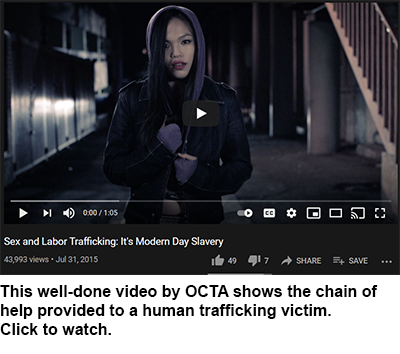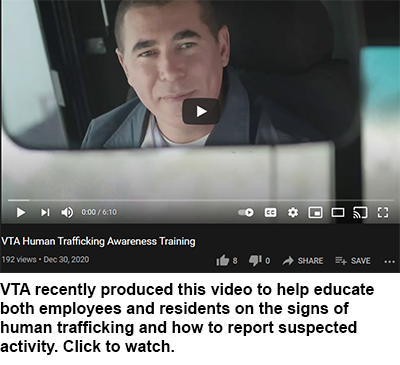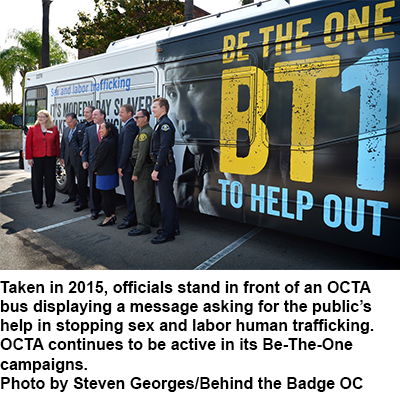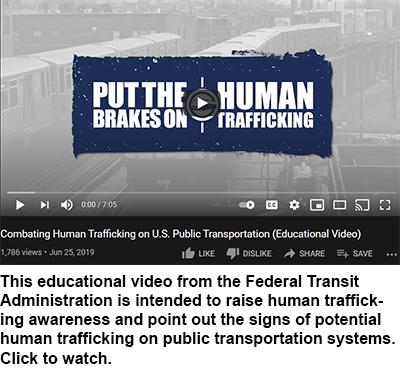By Stephanie Jordan
Managing Editor
Transit California
Many public transit agencies became active in combating human trafficking as early as 2014, but beginning this month, a California law requires public transit and rail agencies to train new and existing employees on how to recognize the signs of human trafficking and how to take action.
On September 27, 2018, then Governor Jerry Brown signed into law Assembly Bill 2034, requiring a variety of businesses and other establishments, starting January 1, 2019, to conduct employee training and to post a compliant notice regarding human trafficking in a conspicuous place near the public entrance of the establishment or in another conspicuous location in clear view of the public and employees.
AB 2034 also mandates that, by January 1, 2021, transit and rail agencies provide at least 20 minutes of training to their new and existing employees who may interact with, or come into contact with, a victim of human trafficking. It further states anyone likely to receive, in the course of employment, a report from another employee about suspected human trafficking also be trained. The required training includes information on recognizing the signs of human trafficking and how to report those signs to the appropriate law enforcement agency.
Why Public Transit?
Human trafficking, a modern form of slavery, is the world’s fastest growing criminal enterprise. After drug trafficking, it is the world’s second most profitable criminal enterprise, grossing more than $150 billion a year. Human trafficking takes several forms but, essentially, it is controlling a person through force, fraud, or coercion to exploit the victim for sex trafficking, forced labor, and/or domestic servitude. Human trafficking can happen to anyone, but especially to people who are already in vulnerable situations.
Transit workers, as front line heroes, are in a unique position to help because movement or relocation of the victim from one place to another is often done to avoid detection or prosecution. Public transit vehicles are hard for law enforcement to trace, are of low cost to the user, and there is limited interaction with officials allowing for more anonymity.

According to the U.S. Department of Transportation (DOT), almost every form of human trafficking intersects with public transportation at some point. Traffickers are particularly interested in runaways and homeless youth that are often found at bus stops, train stations, and transportation hubs, as those places present especially good locations for shelters of last resort.
“The transportation sector can be an effective force against the evils of human trafficking,” says U.S. Transportation Secretary Elaine Chao. “It is in a unique position to help save victims of human trafficking from unimaginable suffering, abuse, and despair and also assist law enforcement officers apprehend the perpetrators.”
Chao called for public transportation leaders to take a stand against human trafficking a year ago when launching “Put the Brakes On Human Trafficking” campaign and the initiation of a Transportation Leaders Against Human Trafficking pledge.
DOT’s 54,000 employees are trained every three years with tailored trainings for bus and truck inspectors to recognize and report human trafficking. The Department also developed a suite of trainings for the aviation, transit, rail, and motor coach industries in coordination with several partners and stakeholders.
VTA

California is one of the top destinations for traffickers in the United States, with 43 percent of all the state’s incidents occurring in the Bay Area. Authored by Assemblymember Ash Kalra (D), San Jose AB 2034 was modeled after Santa Clara Valley Transportation Authority’s (VTA) human trafficking training program, which began in 2015. Because large-scale events known to attract incidents of sex trafficking, VTA’s trained employees were prepared and on the lookout for human trafficking activity throughout Super Bowl 50, which took place at Levi’s Stadium in 2016. Since that time, VTA has been at the forefront of assisting local law enforcement and Santa Clara County in combating human trafficking by training all employees. To date more than 2,000 VTA employees have received the human trafficking prevention training.
Nuria Fernandez, who served as General Manager and CEO of VTA before recently taking a role with the Biden-Harris Administration as Deputy Administrator for the Federal Transit Administration, has an established history of fighting human trafficking. She was a member of the Santa Clara County Human Trafficking Commission from its inception in 2014, which includes law enforcement, social and mental health services, court system representatives, in addition to community organizations that provide resources for victims of violence. The Commission was established to coordinate services for victims and approaches for catching and punishing perpetrators of human trafficking. Fernandez, as VTA GM/CEO, was also actively involved in USDOT Transportation Leaders Against Human Trafficking (TLAHT) initiatives.
“I am proud that California’s AB 2034, which requires all transit agencies to train their frontline employees on how to recognize, and act on, the signs of human trafficking, was modeled after VTA’s training program,” says Fernandez.
Among VTA’s resources to combat Human Trafficking is a $350-thousand- dollar grant from the Federal Transit Administration. VTA is augmenting the grant with its own funding and plans an extensive campaign with the theme Not on Transit (NoT) to reach out to its riders for training, public education, and enhancing its mobile security app VTAlerts to be used to report incidents that happen on transit.
Metro
In the LA area, Metro works closely with its law enforcement agencies — including the Los Angeles County Sheriff’s Department, Los Angeles Police Department, Long Beach Police Departments and Metro security and private security — to remain vigilant in monitoring for suspicious activities such as human trafficking on public transit.
While human trafficking has not been widely reported on the Metro system, the agency is aware that could change as a result of the extreme economic hardships created by the ongoing COVID-19 pandemic.
“Metro wants to prevent incidences of human trafficking on our system,” said Metro CEO Phillip A. Washington in a statement. “We have made a commitment to protect our patrons and to address human trafficking on transit by training our employees and law enforcement contractors on how to identify and report human trafficking incidences.”
Metro’s 11,000 employees, including its bus and rail operators, are among those the agency has trained and educated on how to report suspected human trafficking and help victims who want to file a report. Operators who travel daily through the main trafficking hubs are aware of the signs that someone may require rescue.
In addition, Metro transit riders are encouraged to report incidences they believe may involve human trafficking by calling Metro Security, or using its LA Metro Transit Watch smartphone app, which allows users to add photos and videos, send a text message, or anonymously report suspicious activity.

OCTA
As one of the earliest adopters of human trafficking prevention efforts Orange County Transportation Authority, in 2014, was featured in a Transit California On Board With...for its "Be The One" Campaign. Aimed at riders, the Be The One (BT1) public-awareness campaign featured message wraps on OCTA buses to be displayed throughout OCTA’s service area. The agency’s outreach to help protect human trafficking victims in Orange County through BT1 program continues to this day. BT1 was created to encourage OC Bus riders to be alert and engaged while riding, because riders are often the first to notice if something doesn’t seem right. The campaign asked the public, when it came to human trafficking or potential criminal activity, to say something to the OCTA bus operator to set the wheels in motion to protect lives and rescue those in distress.
OCTA coach operators receive annual training from members of the Orange County Sheriff’s Department Transit Police and the Orange County Human Trafficking Task Force. The agency has published an extensive webpage with information about how to help, what to look for, and what to do. Included in the agency’s website is a section that features stories and interviews directly from the people involved in, and affected by human trafficking.
MST
Human trafficking is an issue that touches every community not just cities, but also suburbs, and rural towns.
“Human trafficking is an issue everywhere. We think of it as a problem in dense, urban, low income areas, but in reality, and with increasing frequency, it is happening in suburban and rural areas,” says Carl Sedoryk, General Manager/CEO at Monterey-Salinas Transit District (MST). “In particular where rural areas are served by long-distance inter-city bus service.”
Sedoryk notes human trafficking is a huge issue in the agricultural fields throughout rural California, including the agricultural fields of Salinas Valley in his area. To comply with AB 2034, MST created its own program combining material from public health services, presentations, videos, and material from other trainers.
“It is impactful for coach operators to see and hear from a victim of human trafficking talk about their experiences, often graphic and jarring, and it definitely has an emotional impact on employees during training,” adds Sedoryk. “We also put a notice out to operators to be extra aware, whenever there is a big event in the area. We know that human trafficking issues spike whenever Monterey area plays host to AT &T Pro-Am, or PGA championship, so we do a refresh on training for the warning signs of human trafficking.”
In a joint outreach effort between MST and the Community Human Services’ Safe Place program, MST buses and trolleys prominently display National Safe Place logos on the exterior and Safe Place posters inside with contact information about the program. The logo indicates to at-risk youth that the buses and trolleys are safe places to ask for help. When a youth, 22 and under, asks for help, transit staff will then contact Safe Place staff who are available 24 hours a day and will respond to the youth immediately to link them to food, shelter, and other emergency services as needed.
“We have had multiple occasions where we have responded to safe place requests,” Sedoryk notes. “It may be because of human trafficking, hunger, homelessness, runaways, or drug addiction. I think it is very possible that the Safe Place may have prevented a human trafficking situation, where an individual was able to escape from whatever it was that prompted the ask for help.”
Proven Success
Sedoryk says training has definitely been fruitful. The MST coach operators actually started making calls into the communication center regarding suspicious activity. In March 2020, MST had a coach operator intervene in a situation where a female at a transit station appeared to be at risk for human trafficking and stayed with her until police arrived to get her to safety.

“This only happened because a trained MST operator noticed the reluctance of a female passenger to go with a male passenger and interceded,” concludes Sedoryk.
According to the USDOT, public transportation plays a role for victims attempting to escape. A survivor survey found that 26 percent of respondents said they used public transportation in at least one of their escape attempts. Buses were most used method of escape because of the relatively low cost and high level of safety.
It was also the human trafficking training effort that was credited in June 2015 when VTA Coach Operator Tim Watson successfully stopped an incident of child abduction taking place on his bus. A “be on the lookout” notice had just been sent from law enforcement authorities prompting VTA’s Operations Control Center to notify all bus and train operators that a 3-year-old boy was kidnapped from the Milpitas Public Library. Watson recognized the signs of suspicious activity and noticed the description of the little boy. Watson then followed established protocol to quickly alert authorities and Operations Control staff. The suspected kidnapper was quickly arrested, and the little boy rescued. In addition to his parental instincts, Watson credited the human trafficking training he received from VTA with helping him thwart the abduction.
Prevention Month
Fear of traffickers, fear of law enforcement, and language barriers are the main reasons victims do not try to escape their situations, especially as victims do not know where to go for help. Putting an end to human trafficking starts with making its existence known, not just for operators, but for the public at large too.
To help raise public awareness, January is Slavery and Human Trafficking Prevention Month. The National Sexual Violence Resource Center (NSVRC) is encouraging organizations to hang up posters, share videos, snap pictures, all to help bring human trafficking out of the shadows and spread the word about human trafficking.
“It may be hard to accept that this crime exists in our communities,” says Megan Thomas, Communications Specialist for NSVRC, “but we have to share the knowledge that this is a reality for far too many victims.”
Through compliance with AB 2034 and alerting riders and educating them on ways to identify signs of trafficking in their communities, public transit can help stop the spread of human trafficking and lead victims to safety.
AB 2034 Mandate
By January 1, 2021, transit and rail agencies are required to be provide new and existing employees with at least 20 minutes of human trafficking awareness training. This mandatory training should include:
- The definition of human trafficking, including sex trafficking and labor trafficking;
- Myths and misconceptions about human trafficking;
- Physical and mental signs to be aware of that may indicate that human trafficking is occurring;
- Guidance on how to identify individuals most at risk for human trafficking;
- Guidance on how to report human trafficking, including, but not limited to, national hotlines (1-888-373-7888 and text line 233733) and contact information for local law enforcement agencies that an employee may use to make a confidential report; and
- Protocols for reporting human trafficking when on the job.
More information can be found on the California Transit Association’s webpage dedicated to Human Trafficking Awareness.